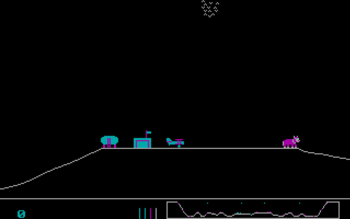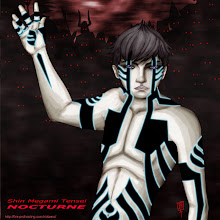Sopwith (computer game)
From Wikipedia, the free encyclopedia
Sopwith is a sidescrolling shoot 'em up created by David L. Clark of BMB Compuscience in 1984. It was originally written to run on the IBM PC under DOS but there was also a port made near the time of its creation for the Atari 520ST. More recent versions have been ported to even more systems. The game involves piloting a Sopwith biplane, attempting to bomb enemy buildings while avoiding fire from enemy planes and various other obstacles.
Sopwith was created to demonstrate the "Imaginet" proprietary networking system developed by BMB Compuscience.[1] David L. Clark, employed as a programmer at BMB, developed Sopwith as a multiplayer game. The multiplayer function will not operate without the Imaginet hardware and drivers. However, single player functionality was also included, with the player flying alone or against computer-controlled planes. Because of this, the game was widely distributed, even though the Imaginet system itself was not hugely successful.
All versions of Sopwith feature four-color CGA graphics. Sound is provided by the PC speaker in the form of music and sound effects.
The C and x86 assembly source code to Sopwith was released in 2000,[2] at first under a non-commercial use license, but later under the GNU GPL at the request of fans.[3]
Contents |
Gameplay
The player begins at their base (typically a hangar and a runway). From here, they must launch their plane and attack targets. This stage can be a hindrance to inexperienced players, as sufficient speed is needed to get the plane into the air. Insufficient speed will cause the plane to stall and crash.
The plane is equipped with a machine gun and a supply of bombs. This weaponry can be used to destroy enemy buildings and shoot down enemy planes. Gauges in the status bar at the bottom of the screen show the remaining lives, fuel, bombs and bullets, respectively.
In Sopwith 2, obstacles exist in the form of Oxen and birds. The oxen simply stand on the ground; if the player crashes into one, they lose 200 points and their plane crashes. The birds provide a more challenging obstacle. Flocks of birds move along the top of the screen. If shot at or flown into, the flock will disperse into individual birds. Flying into a bird causes the plane to crash.
If the player manages to destroy all enemy buildings, the plane turns and flies into the sunset. In Sopwith 1, the game ends. In later versions, the game advances to the next level. Successive levels increase in speed; also, in the second level upwards, buildings shoot back at the player's plane.
The Ox was included as an in-joke and refers to an employee at BMB named "Ox" (aka David Growden) .[4]
Versions
Sopwith 1
The original Sopwith game was released in 1984 and is referred to as "Sopwith 1" by fans. This version had a game clock that was tied to the speed of the hardware: because of this, on later PC hardware, it would run faster than originally intended.
Sopwith 2
A new version was released in 1986 and is referred to as "Sopwith 2" by fans. This fixed the game clock problem of the older version. It also added a number of features:
- Oxen and birds as obstacles to the player
- Advancing levels of difficulty; Sopwith 1 would quit after completing the level.
- Improved computer AI
- The ability to play two player multiplayer games over a serial line (though this is apparently problematic).
Sopwith 2 features the graphical difference of using a line to draw the ground (Sopwith 1 drew the ground as a solid block). This was possibly changed for performance reasons.
Sopwith: The Author's edition
Sopwith: The Author's edition (a.k.a. Sopwith: The network edition) was released in 2000 at the same time as the source code. This contained further features over Sopwith 2:
- Improved AI
- Wounded planes
- Heat-seeking missiles and flares
- Heads-up "splats". When hit by enemy fire, bullet marks would appear on the screen, for example.
Two versions of this exist: one displays "The author's edition" on the title screen, and one displays "the network edition". However, the two versions are equivalent in functionality.
SDL Sopwith
SDL Sopwith is a 100% C port/rewrite of Sopwith 2: The Author's Edition written in 2001 by Simon Howard which utilizes the Simple DirectMedia Layer library to interface with graphics and sound hardware, all while preserving the CGA graphics of the original game. With the source code of this version (which is freely available), SDL Sopwith can be theoretically compiled for any system which has an SDL library available for it, including non-x86 systems.
Trivia
- The title song featured in the game is "The U.S. Air Force", a.k.a. "Off We Go (Into The Wild Blue Yonder)", the US Air Force theme. Although aviation-related, the song itself is an anachronism, firstly because the Sopwith biplanes were used by the British Royal Air Force, never by the United States Air Force, and secondly because the song itself was composed in 1939, while Sopwiths were never produced past 1919.
See also
- Triplane Turmoil, a 1996 VGA Freeware Remake
References
- ^ "Sopwith FAQ". Retrieved on 2006-12-01.
- ^ Clark, Dave (2000-10-29). "Sopwith Code Support". Retrieved on 2006-12-01.
- ^ Clark, Dave. "Sopwith – Source Code". Dave Clark's Home Page. Retrieved on 2006-12-01.
- ^ MacLean, Andrew (1993-10-14). "Sopwith Documentatio(6/6)". comp.sys.ibm.pc.games.action. (Web link). Retrieved on 2006-12-01.



Nenhum comentário:
Postar um comentário